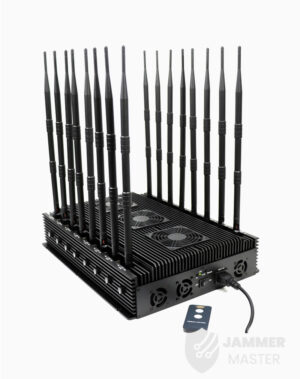
Buying Guide for Portable Signal Jammers
Key Takeaways Consideration Detail Product Weight Jammer Master’s portable jammers average 1.5Kg, significantly lighter than desktop models. Frequency Bands Capable of blocking multiple bands with
Free Worldwide Shipping & 1-Year Warranty!

In today’s era of advanced mobile networks, it has become increasingly important to ensure a fair and secure examination environment. To achieve this, examination centers often employ signal blockers to prevent unauthorized communication during exams. However, it is crucial to test the effectiveness of these blockers to ensure they can shield all types of signals and operate reliably. This article aims to explore the testing methods and considerations for evaluating the performance of examination signal blockers.

Desktop 5G Cellular Signal Jammer Block Cellular/Wireless/GPS/LoJack JM006
$1,839.99
4G Phone Jammer JM021 Block Mobile Phone/WiFi/GPS/LoJack
$520.00
8 Antennas Portable Cell Phone Jammer Block Celluar/WiFi/GPS JM017
$899.00
Portable Cell Phone Jammer Block Cellular/WiFi/GPS/Walkie Talkie JM008
$659.99One of the primary concerns when testing examination signal blockers is their shielding distance. With the prevalence of 4G mobile networks, it is essential to ensure that the blockers have sufficient power to effectively shield the network signals. Inadequate power may result in incomplete blocking, allowing network access within the exam premises. Therefore, it is crucial to assess the shielding distance of the blockers to guarantee their effectiveness.
Another important aspect to consider when evaluating examination signal blockers is their ability to shield all types of mobile networks. Each network operates on different frequencies, and the blockers must be capable of blocking signals from all these networks. During testing, it is common to observe a slight delay in network availability upon turning on the blockers. This delay is necessary to ensure that all signals are effectively blocked, preventing intermittent network access during exams.
During the operation of examination signal blockers, it is essential to monitor their temperature. As the blockers continuously work to shield signals, they tend to generate heat. Over time, this heat can cause a noticeable temperature variation, indicating the effectiveness of the blockers. A significant temperature change suggests that the blockers are efficiently blocking signals, providing a reliable shield against unauthorized communication.
Testing the effectiveness of examination signal blockers is crucial to ensure a fair and secure exam environment. By evaluating the shielding distance, ability to block all types of mobile networks, and monitoring temperature variations, one can determine the reliability and efficiency of these blockers. It is imperative for examination centers to conduct thorough testing using multiple network types to ensure the blockers can effectively shield all signals. Ultimately, the successful implementation of examination signal blockers will contribute to maintaining the integrity and fairness of exams.
Our frequency checker tool will help you check all frequency bands used in all country.

Key Takeaways Consideration Detail Product Weight Jammer Master’s portable jammers average 1.5Kg, significantly lighter than desktop models. Frequency Bands Capable of blocking multiple bands with

In an age where the sky is dotted with drones, the importance of drone jammers has never been more significant. From commercial deliveries to personal

Protect your vehicle’s location privacy with a professional guide on GPS jammers. From selection to legal considerations and installation tips, we’ve got you covered. Key

Understanding Signal Blocker: How It Works and Its Applications Signal Blockers are devices that can disrupt mobile phone signals, preventing them from connecting to base

The Application and Benefits of High-Power Signal Jammers Enhancing Signal Blocking Efficiency in Various Environments In today’s technologically advanced world, the need for effective signal

Considerations for Purchasing Exam Room Signal Jammers Ensuring Effective Signal Jamming for Exam Integrity As the year approaches its end, many schools are preparing for

The Importance of Monitoring and Signal Interference Measures During Examinations During examination periods, it is crucial to closely monitor the examination venues and their surrounding

Selecting the Appropriate Cell Phone Jammer for Theaters and Auditoriums Overcoming Challenges in Installation and Maximizing Signal Disruption The Importance of Cell Phone Jamming in

Remote Control of Cell Phone Jammers via Smartphone: A Possibility? With the rapid development of the Internet of Things (IoT), numerous smart home devices have